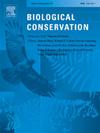Strong land-use change gradients drive consistent patterns in the three-dimensional β diversity of fish in temperate rivers of northeastern China
IF 4.9
1区 环境科学与生态学
Q1 BIODIVERSITY CONSERVATION
引用次数: 0
Abstract
The Sanjiang Plain is one of China's largest and most vital grain-producing regions, with agricultural intensification being one of its most representative characteristics. However, the impacts of this agricultural intensification on local freshwater organisms remain poorly understood. There is an urgent need to analyze the driving weights of natural biogeographic and anthropogenic factors across multiple dimensions, in order to establish a balance point for biodiversity conservation and sustainable agricultural development. Therefore, we examined the relative importance of land use change compared to geographic climate, local environmental factors, and spatial variables on fish community β-diversity, considering three dimensions: taxonomic, functional, and phylogenetic. The results demonstrate a significant ecological information correlation among the three dimensions of β-diversity of fish in the Hulan River, with the turnover component being predominant across all dimensions (89.04 % in taxonomy, 79.40 % in functionality, 83.59 % in phylogenetic). This suggests that species-level management within multiple small spatial scales within the basin can effectively conserve the majority of fish species, functional traits, and lineages. Land use exerts the most significant influence through environmental filtering (pure contribution of variance is 0.061–0.110). Woodland area, turbidity, and water depth are the primary environmental drivers. Strong land-use gradients may have shaped this β-diversity pattern. Fish communities exhibit high sensitivity to alterations in the extent of woodland or cropland. Implementing land use planning with gradient characteristics within the basin, particularly emphasizing the gradient change pattern of woodland, is crucial for maintaining the high β-diversity of fish in the Hulan River.
强烈的土地利用变化梯度驱动东北温带河流鱼类三维β多样性的一致性
三江平原是中国最大、最重要的粮食产区之一,农业集约化是其最具代表性的特征之一。然而,这种农业集约化对当地淡水生物的影响仍然知之甚少。为建立生物多样性保护与农业可持续发展的平衡点,迫切需要从多个维度分析自然生物地理因子与人为因子的驱动权重。因此,我们从分类、功能和系统发育三个维度考察了与地理气候、当地环境因素和空间变量相比,土地利用变化对鱼类群落β-多样性的相对重要性。结果表明,呼兰河鱼类β-多样性的3个维度间存在显著的生态信息相关性,在所有维度中,转换分量占主导地位(分类占89.04%,功能占79.40%,系统发育占83.59%)。这表明,在流域内的多个小空间尺度上进行物种水平的管理,可以有效地保护大多数鱼类的物种、功能性状和谱系。环境过滤对土地利用的影响最为显著(方差的纯贡献为0.061 ~ 0.110)。林地面积、浊度和水深是主要的环境驱动因素。强烈的土地利用梯度可能形成了这种β-多样性格局。鱼类群落对林地或农田面积的变化表现出高度敏感性。在流域内实施具有梯度特征的土地利用规划,特别是重视林地的梯度变化规律,是维持呼兰河鱼类高β-多样性的关键。
本文章由计算机程序翻译,如有差异,请以英文原文为准。
求助全文
约1分钟内获得全文
求助全文
来源期刊

Biological Conservation
环境科学-环境科学
CiteScore
10.20
自引率
3.40%
发文量
295
审稿时长
61 days
期刊介绍:
Biological Conservation is an international leading journal in the discipline of conservation biology. The journal publishes articles spanning a diverse range of fields that contribute to the biological, sociological, and economic dimensions of conservation and natural resource management. The primary aim of Biological Conservation is the publication of high-quality papers that advance the science and practice of conservation, or which demonstrate the application of conservation principles for natural resource management and policy. Therefore it will be of interest to a broad international readership.
 求助内容:
求助内容: 应助结果提醒方式:
应助结果提醒方式:


